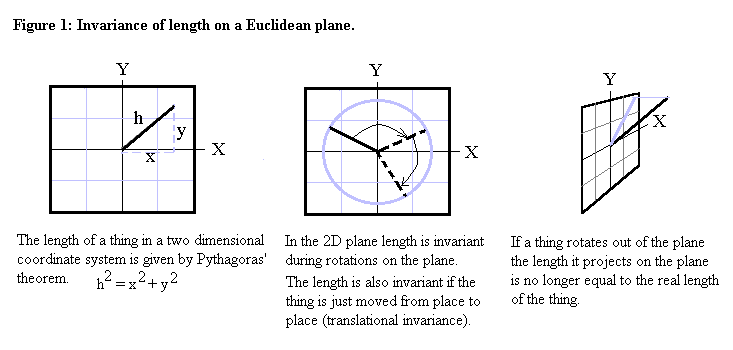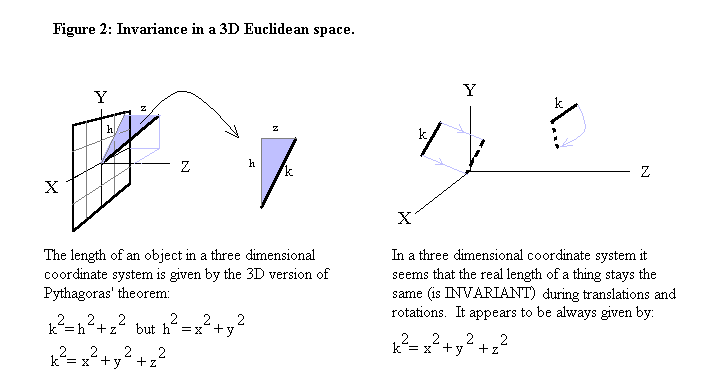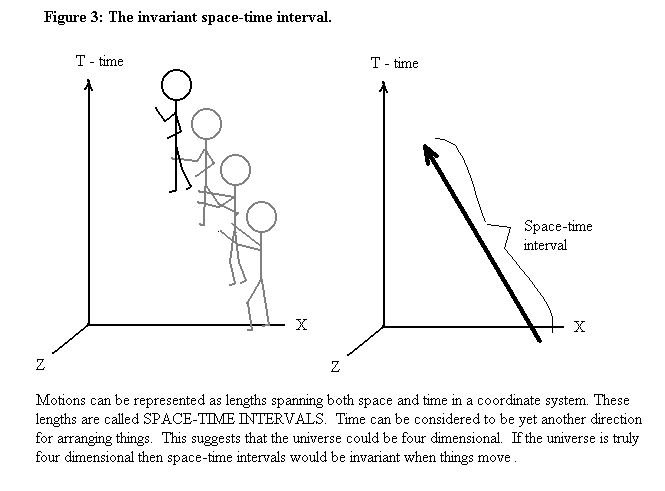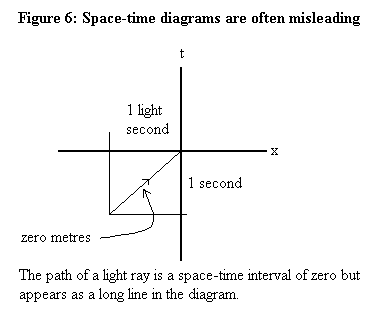Introduction to special relativity
2007 Schools Wikipedia Selection. Related subjects: General Physics
The beginning
Everything started with the Michelson-Morley experiment to determine the absolute speed of the Earth through the theorised "luminiferous aether." The experiment was a failure but it did show something: the speed of light is independent of the speed of the observer. This means that two persons that follow the same light ray at different speeds will measure the same relative speed for the ray.
There were several articles before Einstein's trying to explain how this could happen. The most important was written by Lorentz, who postulated that light travels at a speed of c through the ether, and that when other objects move through the ether, they are compressed in the direction of motion, and their time slows down. He still had in mind absolute movement, and was thinking that a moving observer would measure the correct speed of light by a compensation of errors. If her reference frame is moving along with the light, then the speed of light relative to her is slower, but the contraction of the length of her instruments and the slowdown of her time are exactly enough for her to measure the speed of light as c.
Einstein explained the same effect in a simpler way using the relativity principle. He imagined a ray of light bouncing between two mirrors. For an observer static with the mirrors this takes a given time. For an observer moving with respect to them this takes longer (the speed of light is the same and the space is more). From here he calculated the equation for transforming time.
Later, using the previous equation, he discovered that simultaneity was not possible for all inertial systems. If we synchronize several clocks in a frame, they will look desynchronized from a frame at different speed.
Finally, he used the previous results to obtain the same equation as Lorentz had for space contraction.
After he did this, a lot of people, including himself, tried to find any inconsistencies in the system. A lot of supposed inconsistencies (or paradoxes) were proposed. He took the job of looking for an explanation for all of them one by one, until another scientist, named Hermann Minkowski, showed that the whole system of the special relativity is self-consistent and therefore no real paradox can appear.
Minkowski Space
Also, the modern approach to the theory depends upon the concept of a four-dimensional universe that was first proposed by Minkowski in 1908, and further developed as a result of the contributions of Emmy Noether. This approach uses the concept of invariance to explore the types of coordinate systems that are required to provide a full physical description of the location and extent of things.
The modern theory of special relativity begins with the concept of " length". In everyday experience, it seems that the length of objects remains the same no matter how they are rotated or moved from place to place. We think that the simple length of a thing is " invariant". However, as is shown in the illustrations below, what we are actually suggesting is that length seems to be invariant in a three-dimensional coordinate system.
The length of a thing in a two-dimensional coordinate system is given by Pythagoras' theorem:
This two-dimensional length is not invariant if the thing is tilted out of the two-dimensional plane. In everyday life, a three-dimensional coordinate system seems to describe the length fully. The length is given by the three-dimensional version of Pythagoras's theorem:
The derivation of this formula is shown in the illustration below.
It seems that, provided all the directions in which a thing can be tilted or arranged are represented within a coordinate system, the coordinate system can fully represent the length of a thing. However, it is clear that things may also be changed over a period of time. We must think of time as another dimension through which we move forward. This is shown in the following diagram:
The path taken by a thing in both space and time is known as the space-time interval.
Minkowski realised in 1908 that if things could be rearranged in time, then the universe might be four-dimensional. He boldly suggested that Einstein's recently published theory of special relativity was a consequence of this four-dimensional universe. He proposed that the space-time interval might be related to space and time by Pythagoras' theorem in four dimensions:
Where i is the imaginary unit (defined as one of the solutions of x2 = −1), c is the speed of light (a constant), and t is the time interval spanned by the space-time interval, s. In this equation, the "second", usually a unit of time, becomes just another unit of length. In the same way as centimetres and inches are both units of length related by centimetres = conversion factor × inches, metres and seconds are related by metres = conversion factor × seconds. The conversion factor, c, has a value of approximately 300,000,000 meters per second. Because i2 is equal to −1, the space-time interval can be represented by:
In modern formulations this formula for intervals is known as a metric tensor on the Minkowski space with the signature (−+++) or equivalently (+−−−). It is of particular importance that this form where one term has a sign different from the rest is in direct contrast to the above-mentioned example of euclidean space where all terms have the same sign, a signature of (++++). It is this difference in metric signature that causes the principal difference between geometry in a four-dimensional Euclidean space and geometry in the four-dimensional Minkowski space. The space-time interval is still given by:
or alternately
Space-time intervals are difficult to imagine; they extend between one place and time and another place and time, so the velocity of the thing that travels along the interval is already determined for a given observer. But attempts at visualisation can be made by graphing the displacement of a particle in one-dimensional motion (constrained to a straight line) against time. This can be imagined as a world line when the two other space dimensions are suppressed.
If the universe is four-dimensional, then the space-time interval will be invariant, rather than spatial length. Whoever measures a particular space-time interval will get the same value, no matter how fast they are travelling. The invariance of the space-time interval has some dramatic consequences.
The first consequence is the prediction that if a thing is travelling at a velocity of c metres per second, then all observers, no matter how fast they are travelling, will measure the same velocity for the thing. The velocity c will be a universal constant. This is explained below.
When an object is travelling at c, the space time interval is zero:
- The space-time interval is

- The distance travelled by an object moving at velocity v for t seconds is:
- So:

- But when the velocity v equals c:
- And hence the space time interval

A space-time interval of zero only occurs when the velocity is c. This particular value of zero for the interval is unique in the sense that it is the only value of the space-time interval for which v can have one and only one value. This shows that not only is the velocity of light constant, it is the only velocity constant. Therefore, by assuming the particular form of the Minowski metric and postulating the invariance of space-time interval, we have an alternate approach to Einstein's special relativity where Einstein takes it as a postulate that the speed of light is constant. When observers observe something with a space-time interval of zero, they all observe it to have a velocity of c, no matter how fast they are moving themselves.
The universal constant, c, is known for historical reasons as the "speed of light". In the first decade or two after the formulation of Minkowski's approach many physicists, although supporting special relativity, expected that light might not travel at exactly c, but might travel at very nearly c. There are now few physicists who believe that light (or any other EM wave) does not propagate at c.
The second consequence of the invariance of the space-time interval is that clocks will appear to go slower on objects that are moving relative to you. Suppose there are two people, Bill and John, on separate planets that are moving away from each other. John draws a graph of Bill's motion through space and time. This is shown in the illustration below:
Clocks delays and rods contractions
Being on planets, both Bill and John think they are stationary, and just moving through time. John spots that Bill is moving through what John calls space, as well as time, when Bill thinks he is moving through time alone. Bill would also draw the same conclusion about John's motion. To John, it is as if Bill's time axis is leaning over in the direction of travel and to Bill, it is as if John's time axis leans over.
John calculates the length of Bill's space-time interval as:
whereas Bill doesn't think he has traveled in space, so writes:
The space-time interval, s2, is invariant. It has the same value for all observers, no matter who measures it or how they are moving in a straight line. Bill's s2 equals John's s2 so:
and
hence
 .
.
So, if John sees Bill measure a time interval of 1 second (T = 1) between two ticks of a clock that is at rest in Bill's frame (modeled by the condition (X = 0), John will find that his own clock measures between these same ticks an interval t, called coordinate time, which is greater than one second. It is said that clocks in motion slow down, relative to those on observers at rest. This is known as "relativistic time dilation of a moving clock". The time that is measured in the rest frame of the clock (in Bill's frame) is called the proper time of the clock.
John will also observe measuring rods at rest on Bill's planet to be shorter than his own measuring rods, in the direction of motion. This is a prediction known as "relativistic length contraction of a moving rod". If the length of a rod at rest on Bill's planet is X, then we call this quantity the proper length of the rod. The length x of that same rod as measured on John's planet, is called coordinate length, and given by
 .
.
Clocks desynchronization
The last consequence is that clocks will appear to be out of phase with each other along the length of a moving object. This means that if one observer sets up a line of clocks that are all synchronised so they all read the same time, then another observer who is moving along the line at high speed will see the clocks all reading different times. This means that observers who are moving relative to each other see different events as simultaneous. This effect is known as "Relativistic Phase" or the "Relativity of Simultaneity". Relativistic phase is often overlooked by students of special relativity, but if it is understood, then phenomena such as the twin paradox are easier to understand.
The net effect of the four-dimensional universe is that observers who are in motion relative to you seem to have time coordinates that lean over in the direction of motion, and consider things to be simultaneous that are not simultaneous for you. Spatial lengths in the direction of travel are shortened, because they tip upwards and downwards, relative to the time axis in the direction of travel, akin to a rotation out of three-dimensional space.
Great care is needed when interpreting space-time diagrams. Diagrams present data in two dimensions, and cannot show faithfully how, for instance, a zero length space-time interval appears.
Common misconceptions
It is a common misconception that special relativity only applies to objects that are moving quickly. This is entirely untrue. In the main page, it is shown that the kinetic energy of an object at all speeds is a relativistic quantity. Kinetic energy is relativistic because, although relativistic changes in mass are tiny in ordinary units, these result in large changes in energy in ordinary units, due to E = mc2 where c2 is about 90,000,000,000,000,000 m2/s2. Newtonian physics describes the interplay between kinetic and potential energy, without explaining the origin of kinetic energy or inertia; it just assumes these things, whereas special relativity explains them at a deeper level.
It should be pointed out however, that Minkowski was partly motivated in his proposal of a four-dimensional universe by Franz Taurinus' discovery that Euclidean geometry, with the exception of the fifth postulate, applies on the surface of a sphere, with a radius measured in imaginary units (i), and cannot be assumed as a fundamental geometry in any universe (see Non-Euclidean geometry and Walter(1999)).
Caveats and Warnings
The discussion given above has been confined to what is known as "flat space-time". The general, differential form of the space-time interval is given in the article Special relativity. The modern description of the universe uses the term (3+1)D rather than 4D to show how time is not like the spatial dimensions. This corresponds to the difference of the 4D Euclidean metric and the (3+1)D Minowski metric mentioned earlier.
The time dilation equation
 .
.
is valid for a clock that is at rest in Bill's frame, measuring proper time T. This equation is only valid when the two tick events of the clock happen at the same place in Bill's frame; in other words, for two events satisfying X = 0.
The length contraction equation
 .
.
is valid for a rod that is at rest in Bill's frame, with proper length X. If the rod is to be measured in John's frame, then John must make sure to measure both end points of the rod at the same time in his own frame, so he must use two events satisfying t = 0.
It can be tempting to combine the above equations for time dilation and length contraction to some kind of 'invariant spacetime area' xt = XT or some kind of 'velocity that transforms like' x/t = X/T (1-v^2/c^2), but taking into account the above, and combining them with the Lorentz transformation, the equations immediately reduce to the trivial case where all the quantities are zero: x = t = X = T = 0, in which case the 'area equation' reduces to 0 = 0 and the quantities x/t and X/T are not defined. In a sense the combined equations would only be valid for a rod with zero length that is also a clock that does not tick.
It should also be made clear that the length contraction result only applies to rods aligned in the direction of motion. At right angles to the direction of motion, there is no contraction.
It might also be noted that special relativity, in the form given above, is only a stepping stone to general relativity. In special relativity, space-time is absolute, and appears as a background against which events occur; whereas in general relativity, space-time is construed to be a dynamic product of the gravitational field, and the Minkowski metric no longer applies in general. Instead, every situation demands its own metric which are solutions to the famous Einstein field equations.
Measurement Units, and Simplifications to the Lorentz Equations
The equations above do not specify what the units of measurement are for times and distances. The following discussion, however, will only focus on the section on the Lorentz equations. Suppose we choose some arbitrary time unit, and some arbitrary distance unit. Then the equations above are still valid, provided the constant  is the speed of light measured with respect to these units. For example, if the unit of time is the second, and the unit of distance is the meter, then the value of
is the speed of light measured with respect to these units. For example, if the unit of time is the second, and the unit of distance is the meter, then the value of  is exactly 299,792,458 meters per second.
is exactly 299,792,458 meters per second.
- Side note: The 299,792,458 figure is exact, for the following reason. In the past, the second was defined as a subdivision of a day (the time between successive solar noons). The meter was defined independently of time, as a fraction of the distance from the equator to the north pole, and was standardized as the length of ruler kept in Paris. Yet with the advent of atomic clocks, and the discovery of the invariance of the speed of light, the definition of the second and meter were altered. The second now is defined with respect to the vibration-periods of certain atoms in certain energy states. The meter now is defined as 1/299,792,458 th of the distance that a beam of light travels in one second. So, rather than estimate the speed of light as a function of the length of a physical object, which is imprecise, we now use the absolute constant, the speed of light, and the definition of the second (presumably based on a highly invariant physical entity) to define what we mean by a "meter."
Now, suppose rather than use meters to measure distance, we let our unit of measurement be the distance light travels in one second, which is called a "light-second." In terms of meters, one light second is exactly defined as 299,792,458 meters. One beneficial result of using these units of measurement is that the value of  is now 1 in the equations above ( since light travels exactly ONE light-second, every second ). So all the
is now 1 in the equations above ( since light travels exactly ONE light-second, every second ). So all the  's can be removed. The only thing to remember is that now all distances should be in terms of light-seconds, not meters. Note, also, that there is nothing special about using seconds as the unit of time, as long as the unit of distance is the distance traveled by a beam of light in one unit of time. For example, if time is measured in years, then distance should be measured in light-years.
's can be removed. The only thing to remember is that now all distances should be in terms of light-seconds, not meters. Note, also, that there is nothing special about using seconds as the unit of time, as long as the unit of distance is the distance traveled by a beam of light in one unit of time. For example, if time is measured in years, then distance should be measured in light-years.
The simplified equations are:
where 
In their Spacetime Physics Taylor and Wheeler present another way to look at and think about the variables and equations when they are written this way (i.e. with "units where c = 1"). The variable  is kept as the normal speed of light, but the v-variable is now defined as
is kept as the normal speed of light, but the v-variable is now defined as
where  is the conventional velocity that appears in the original non-simplified equations. Then, depending on the problem or situation at hand one can choose to
is the conventional velocity that appears in the original non-simplified equations. Then, depending on the problem or situation at hand one can choose to
- either measure and express time in units of conventional distance (e.g. meters), and define the t-variable as
- or measure and express distances in units of conventional time (e.g. seconds or years), and define the spatial variables x, y, z as
Similar definitions can then be used for the other variables like energy:
etc... This way the speed of light effectively disappears from all the equations.






















